The AMD Radeon VII Review: An Unexpected Shot At The High-End
by Nate Oh on February 7, 2019 9:00 AM ESTProfessional Visualization and Rendering
With AMD strongly pushing the Radeon VII as a prosumer content creation card, it behooves us to look at rendering, CAD, and professional visualization performance. However, accurate and applicable benchmarks for this field are not so easy to find, especially since performance is highly dependent on workflow and proprietary licensed ISV software. Given AnandTech’s audience, which often includes engineers using these applications in critical production environments, our goal is to provide the most relevant metrics. However, as Ian has discussed previously, the route to the most accurate workstation benchmarking for professional applications is in the hands of ISVs, who are at best blasé and more typically negative about providing access, even at the prospect of lending limited software licenses in return for ongoing discussion and third-party benchmark data of their software.
Those caveats in mind, the next best thing for evaluating overall GPU workstation performance is the venerable SPECviewperf, recently updated to version 13. Separated into ‘viewsets,’ which are a group of application-specific workloads derived from real-world datasets, SPECviewperf has been a longstanding suite for generalized workstation/CAD GPU performance. For SPECviewperf 13, the viewsets are based on:
- Autodesk 3ds Max 2016 (Nitrous DX11 driver)
- Dassault Systèmes CATIA V6 R2012
- PTC Creo 3 & Creo 4
- Geosurvey software, with workloads based on rendering techniques utilized by the open-source OpendTect seismic visualization application
- Autodesk Maya 2017
- Radiological (i.e. CT, MRI scans) rendering, with workloads using the Tuvok rendering core of the ImageVis3D volume visualization application
- Autodesk Showcase 2013
- Siemens NX 8.0
- Dassault Systèmes Solidworks 2013 SP1
While we didn’t have time for complete benchmarking of video editing/production software such as Adobe Premiere Pro CC, we will be looking to include that in the future.
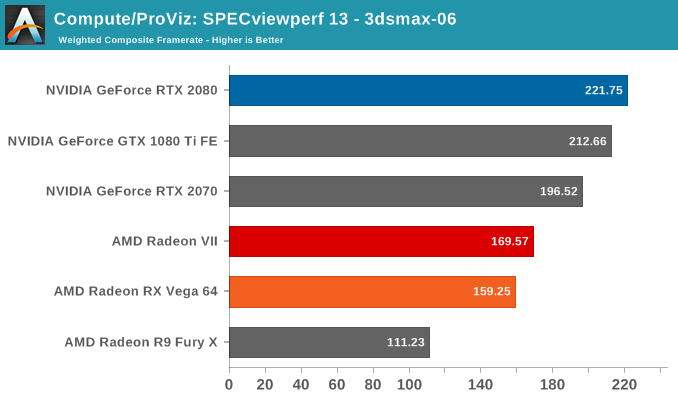
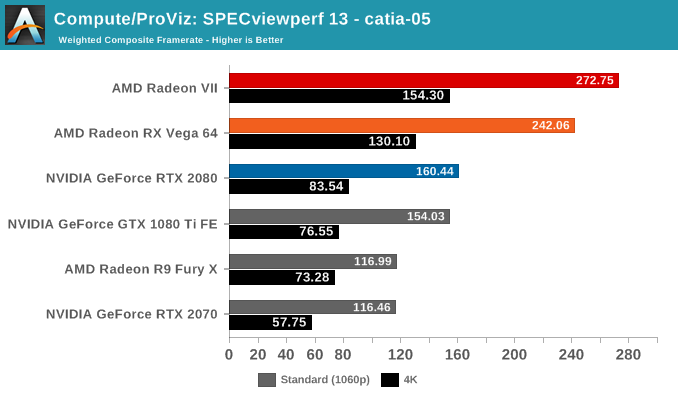

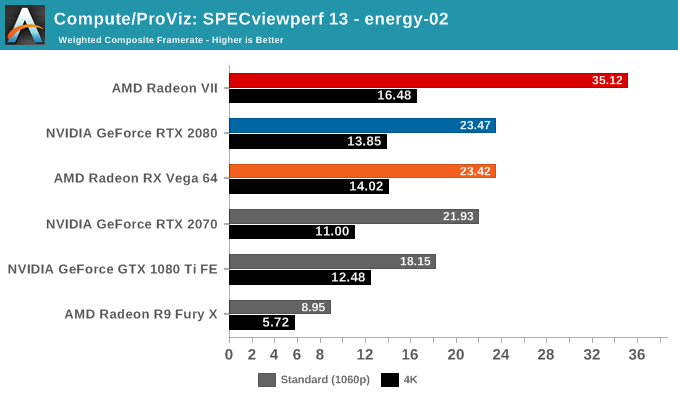
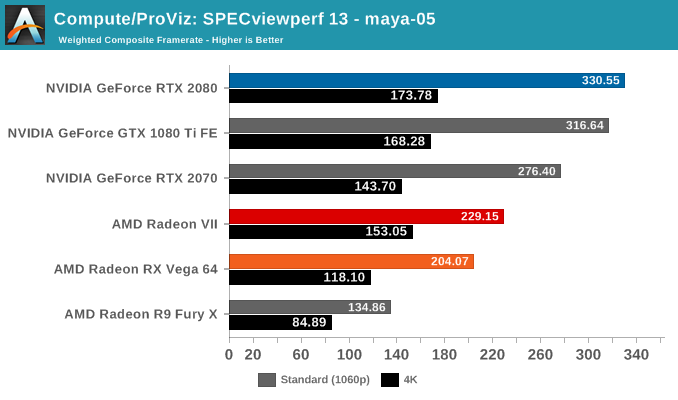
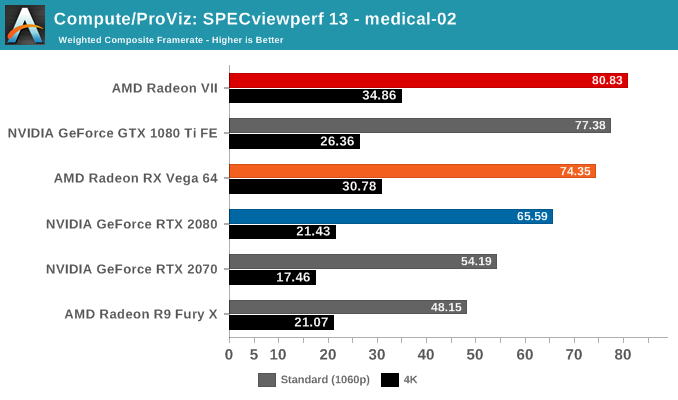
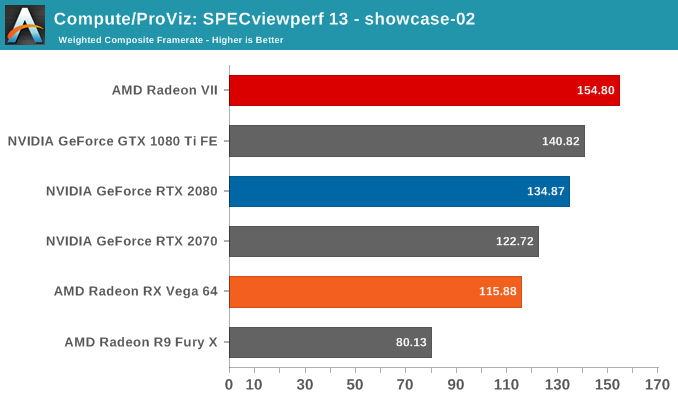
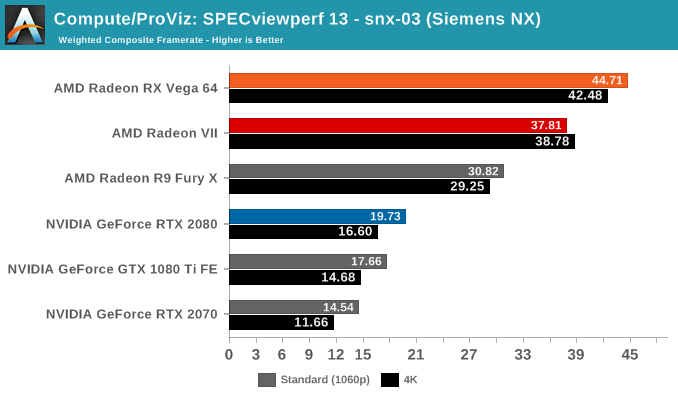
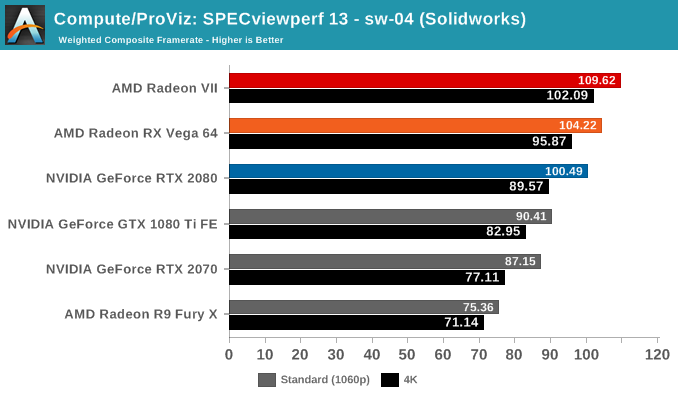
Looking over the results, it's clear that certain viewsets tend to perform better on one vendor's hardware than the other's. In those cases, the Radeon VII doesn't buck the trend, though in Siemens NX the lower performance is more likely than not related to driver maturity. In the reverse scenarios like in creo-02 or maya-05, the Radeon VII is in a similar spot, naturally ahead of the RX Vega 64 but behind the competing RTX and GTX cards. If anything, the results highlight the importance of software maturity for newer hardware, but there are definite signs of Vega 20 being a powerful workstation card. The caveat is that it doesn't seem to change the overall landscape for worksets that traditionally perform well on NVIDIA hardware.
Our next set of benchmarks look at rendering performance. To be clear, given the nature of ‘render wars’ as well as the adoption of CUDA, the featured render engines are not necessarily indicative of the overall GPU renderer landscape. Because we are looking at the Radeon VII, it’s not applicable to include some of the more popular renderers, such as Redshift and Octane, which are CUDA-only, and similarly the presence of Indigo Renderer helps as another datapoint even though it is less popular.


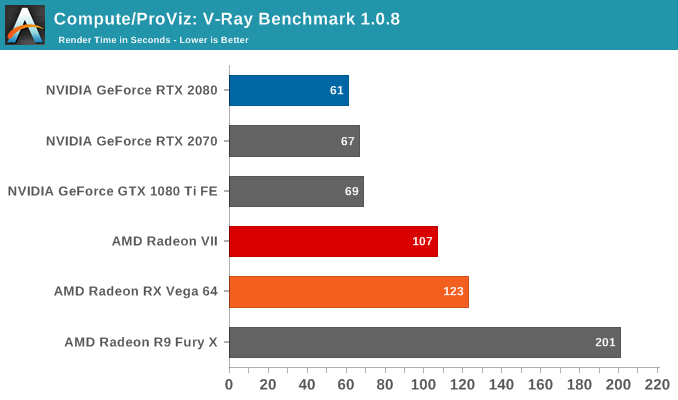

To note, official Blender releases have yet to incorporate CUDA 10, and so RTX 20 series cards are not officially supported.
V-RAY here is the only test that utilizes CUDA for NVIDIA cards, while the rest all use OpenCL. The results seem broadly similar to SPECviewperf, where the Radeon VII continues to excel at workloads where AMD hardware generally fare well.










289 Comments
View All Comments
29a - Thursday, February 7, 2019 - link
As usual in these garbage articles the prices given are nowhere near reality. The Vega 64 is $100 cheaper than what is listed.RSAUser - Thursday, February 7, 2019 - link
Anandtech doesn't ever seem to update reviews or prices.They'll compare a device from their history even if there have been months of driver updates that fixed performance issues, so they'll be using non-current info and everyone will assume it's current.
Ryan Smith - Thursday, February 7, 2019 - link
"Anandtech doesn't ever seem to update reviews or prices."On the contrary, quite a bit was updated for this review. Though as driver performance has been rather stable as of late, performance hasn't exactly gone anywhere for most cards on most games.
If you see anything that seems wrong, please let us know. But we go out of our way to try to avoid using any card/driver combinations that result in performance issues.
Korguz - Thursday, February 7, 2019 - link
29aif you think AT does nothing but garbage articles.. then, lets see YOU do better...
as for prices.. meh.. thats something hard to account for as there are things called exchange rates, and other variables that no one can predict.....
Phil85 - Thursday, February 7, 2019 - link
So when will prices of GPU's decrease? Is this the new normal?eva02langley - Thursday, February 7, 2019 - link
Navi should bring value back to mid-range.It is still a nice card for professional/compute/rendering. But for gaming, the price is maybe 50$ too expensive, and AMD really needs to get some better quality fans.
TEAMSWITCHER - Thursday, February 7, 2019 - link
If Navi is missing next generation features like ray tracing and tensor cores, there will be ZERO value to it.eva02langley - Thursday, February 7, 2019 - link
AHAHAHAHA... Ray Tracing... you know the real problem of Ray Tracing? It was never on the table until Jensen brainwashed shill that it was important. by defending it, you obviously prove that you have no critical judgement.By the way, the problem with RT/DLSS is that it will never be implemented because AMD owns consoles, and that devs develop on consoles. There is no monetary benefit to implement gimmick proprietary gameworks features for 1% of the PC user base, unless if Nvidia is paying you to do so.
It will never be a thing for the upcoming console generation. See you in 7 years, where it might be remotely relevant to the industry. As of now, unless you are rendering a CGI movie, it is worthless.
Dribble - Thursday, February 7, 2019 - link
Both the next gen consoles are going to have ray tracing. Microsoft - who wrote and own the spec for the DX12 ray tracing extension currently used by PC's and hence a strong backer of ray tracing - will make one of them.eva02langley - Thursday, February 7, 2019 - link
Not going to happen because RTX is proprietary, it is a closed environment, and require hardware acceleration that AMD is not going to pursue in the short time. Nvidia shoot themselves in the foot by pushing it. Open source is the only way a new standard can be adopted. The whole G-synch fiasco should have been enough to prove it.Hardware could run it still, but the impact on performances is just to important. At that point, developers like Sony have incredible talent in creating new effect that look way more realistic.
Just looking at The Last of Us Part 2 is a good example.